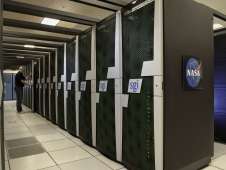NASA Supercomputer Doubles Capability, Increases Efficiency

(PhysOrg.com) -- Pleiades, NASA’s supercomputing powerhouse, located at Ames Research Center, Moffett Field, Calif., placed sixth on the Top500 list of the world's most powerful, high-performance computers. The announcement was made June 1, 2010 at the 25th International Supercomputing Conference in Hamburg, Germany.
Since garnering the sixth spot in fall 2009, Pleiades has doubled the science and engineering performance capabilities available to general users through successful integration of 32 new SGI Altix ICE 8400 systems by a team at the NASA Advanced Supercomputing (NAS) Division at Ames. Pleiades now boasts 18,432 Intel Xeon quad- and hex-core processors (81,920 cores in 144 racks) that can run at a theoretical peak of approximately 973 trillion floating point operations per second and sustains performance at approximately 773 teraflops on the LINPACK benchmark, the industry standard for measuring a system’s floating point computing power.
"Integrating the new racks and bringing the Pleiades expansion online involved an extreme effort of a dedicated team of experts from NAS and SGI to correctly connect more than 4,000 cables, and test all of the memory, processors and connections," said William Thigpen, chief of the Systems and Engineering Branch in the NAS Division. "The expanded system is already being fully utilized and is hammering away at full throttle to successfully meet the demand of scientists and engineers across NASA."
One of the most powerful general-purpose supercomputers ever built, Pleiades' upgrades make it increasingly energy efficient - an important consideration in high-end computing. Benchmark tests also confirm the addition to the Pleiades system is three times more power-efficient on production codes than the original Pleiades components, which were the most power-efficient at the time.
"The NAS can now deliver twice the sustained computing capability to NASA scientists, which reduces simulation turnaround times and supports higher fidelity models," said Bob Ciotti, supercomputing systems lead in the NAS Division at Ames. "These improvements are achieved while utilizing only one third the amount of electricity and represent the current state-of-the-art in supercomputing."
Originally installed in 2008, when it placed third on the November 2008 TOP500 list, Pleiades was acquired to augment NASA's high-end computing requirements to support four key mission areas: aeronautics, exploration systems, science, and space operations. NASA currently supports a variety of scientific and engineering projects, including coupled atmosphere-ocean models to assess decadal climate prediction for the Intergovernmental Panel on Climate Change; future space vehicle design; detailed models of large-scale dark matter halos and galaxy evolution.
"NASA continues to push the boundaries of supercomputing performance and set new standards for energy efficiency and density with SGI equipment," said Mark J. Barrenechea, chief executive officer of SGI. "SGI is a committed NASA partner and provides the necessary infrastructure and new technologies to enable the institution’s critical research."
"It is exciting to see NASA fully leverage the capabilities of the Intel Xeon processor 5600 series with the Pleiades supercomputer to become fifth on the TOP500 list,” said Richard Dracott, general manager of Intel's High Performance Computing Group. “SGI and Intel together provide high density solutions for the world’s top supercomputing centers to support ever-increasing workload demands."
The NAS facility continues to feature the world's largest InfiniBand interconnect network with 9,216 nodes and more than 45 miles of cabling, consisting of double data rate, quad data rate, and hybrid cables. The InfiniBand fabric interconnecting Pleiades' 7,040 nodes requires almost 24 miles of cabling, InfiniBand also serves as the primary local-area network backbone that interconnects computing, storage, and visualization systems, and to facilitate cross-system data file access. This enables scientific visualization and data analysis to execute concurrently as computer jobs run, producing ultra-high-fidelity results for NASA's enormous datasets.
Provided by JPL/NASA















